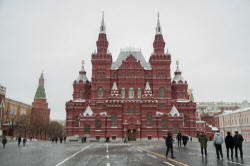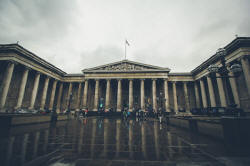Delta Module One, Paper 1, Task 3 : what learners need to know (2)

You will be given a section of published ELT materials and
directed to some of the language features learners would need to be
able to command successfully to complete the task.
Your task is to provide three more things they need to know
with examples of what you mean.
This question carries 12% of the possible marks so spend no more
than 10 minutes on it.
What follows is much longer than the type of item you will get in the examination proper. Take as long as you like and consider each one of the five activities based on the texts and pictures separately.
This task for the learners at B1 level and is a listening and matching task, followed by a speculation and speaking task. It comes in five parts:
- The learners are given four pictures of museums and required to listen to people describing their visit to each of them. They have to match the picture to what they hear.
- They then compare their answers in pairs, saying what they heard that helped them find the answers, to make sure they agree and listen again to check.
- They have to discuss with their partners whether the speakers, Mary and Fred enjoyed their visits or not and why.
- They have to say where they think the buildings are and explain why they think so to their partner.
- They have to agree with their partners on a list of 5 things that they would expect to find inside a history museum.
The four pictures and the tapescripts are as follows (the learners get only the numbered pictures):
 |
 |
| We went
there last spring while we were on holiday to get a break
from the hustle of the city. Inside it's fabulous with
lots of beautiful ceilings and some great exhibits, mostly
paintings but lots of other stuff, too. It's a huge palace built in a baroque style with a controversial modern bit in front of it. The modern bit looks a bit like a crystal but I think it's attractive although I have to admit it doesn't really fit in. We spent hours there and could have spent longer. |
We went
while we were touring around because Mary had always wanted
to see it. She'd learned about it at school you see.
She loved it to bits. It's a good place just to hang
out if the weather's fine. You have to climb up a lot of steps to get to it but the views from the front are pretty impressive. I was a bit disappointed by it frankly because there isn't much to see inside but I liked the colonnaded front and the fact that it's all built in nearly white marble. |
 |
 |
| It was
freezing the day I took the picture and my hands were so
cold I nearly dropped the camera. It's pretty impressive really, I suppose, standing as it does at the end of the square and with all the towers and turrets on it but I don't like the dark peach colour much and it cost a lot to get in. We took a cab to get there and it was able to drop us right outside the front door because the road runs almost up to it. There's a lot to see inside if you like that kind of thing so I guess it's worth the money but I wouldn't go again. |
This is
definitely one not to miss if you are ever in town and have
a few hours to spare. Even from the outside, it's pretty impressive with all the columns and so on but it's the inside that really got me intrigued. It's built around three sides of a huge courtyard and you have to go in through the entrance on the right. Over the top of the central bit there's a carved frieze but, to be honest, I don't remember what that's about. I enjoyed it but Fred just went to get in out of the rain! |
The learners will, of course, need to be able to:
- Understand most of the content and not be overwhelmed by too much unknown lexis.
- Be able to use some language of speculation such as I think it is in ...
- Be able to give reasons using at least ... because ....
Can you come up with three more things
with examples that the learners will need to
be able to do to complete the task? In the examination, you
only need three but think of more if you can.
Click here
for a list of 10 possibilities when you have.
- They will need to be able to listen for salient information describing the buildings and ignore irrelevance such as comments about the weather and reasons for being there (freezing, to get a break from the hustle of the city, just went in to get out of the rain) and the speakers' reactions to what was inside (task 1).
- They will need to recognise at least some key lexis such as column, frieze, square, crystal, steps, courtyard, marble etc. (task 1).
- They will need to be able to remember and use some of this lexis when explaining what alerted them to each picture, e.g., dark peach colour, the road runs almost up to it, three sides of a huge courtyard (task 2).
- They will need to be able to deploy some epistemic modal language such as might, could, probably, possibly, obviously, it seems to me ... etc. (tasks 2, 3 and 4).
- They will need to be able to decipher the language of opinion in the texts such as disappointed, one not to miss, if you like that kind of thing, loved it to bits, got me intrigued etc. (task 3).
- They will need some awareness of intonation patterns expressing disinterest (lowered voice tone of if you like that kind of thing, for example) or enthusiasm (stress and rising intonation on positive adjectives such as fabulous etc.) (task 3).
- They will need some knowledge of the world to know what sorts of things historical museums usually contain including, for example, cultural items, jewellery, old masters, carvings etc. (task 4).
- They will need the lexis to be able to come up with a list of items (exhibits, paintings, artefacts, statues, objects etc.) (task 4).
- They may need to be able to use bi-lingual dictionaries to fill in the gaps in their vocabulary such as not knowing, for example, ancient, historic, important archeological find etc. (task 4).
- They will need some negotiating language (such as I think we definitely need to include ..., don't you?) (task 5).
You may have thought of others. You only have to find three but you must exemplify all of them (as above).
| Paper 1 revision test index |
